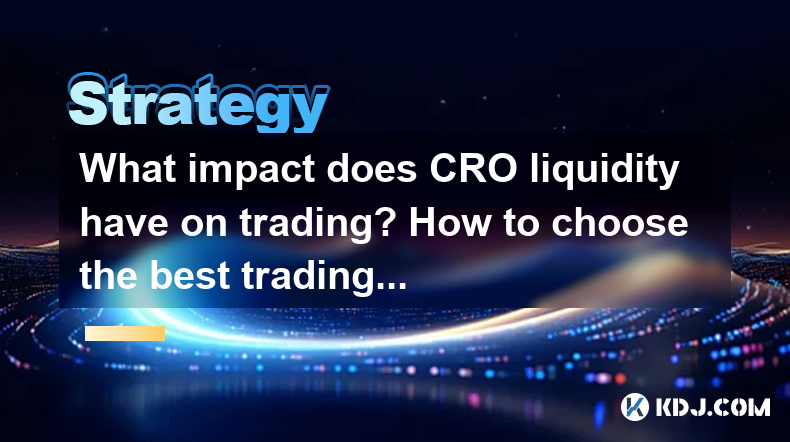-
 bitcoin
bitcoin $107208.295278 USD
-1.54% -
 ethereum
ethereum $3874.629914 USD
-1.38% -
 tether
tether $1.000440 USD
0.03% -
 bnb
bnb $1089.465513 USD
-5.53% -
 xrp
xrp $2.327672 USD
-1.65% -
 solana
solana $184.766505 USD
-0.73% -
 usd-coin
usd-coin $1.000076 USD
0.02% -
 tron
tron $0.310632 USD
-1.99% -
 dogecoin
dogecoin $0.187615 USD
-1.60% -
 cardano
cardano $0.633389 USD
-2.75% -
 ethena-usde
ethena-usde $0.999553 USD
0.03% -
 hyperliquid
hyperliquid $35.608231 USD
-4.13% -
 chainlink
chainlink $16.876114 USD
-3.98% -
 stellar
stellar $0.312239 USD
-0.91% -
 bitcoin-cash
bitcoin-cash $473.262969 USD
-7.09%
What impact does CRO liquidity have on trading? How to choose the best trading time?
CRO liquidity impacts trading by affecting bid-ask spreads, trade execution speed, and strategy effectiveness, with high liquidity enabling smoother and more cost-effective trades.
May 01, 2025 at 08:14 am

The impact of CRO liquidity on trading is a critical aspect that traders must consider to optimize their trading strategies. Liquidity refers to the ease with which an asset can be bought or sold in the market without affecting its price significantly. For CRO, the native cryptocurrency of the Crypto.com ecosystem, high liquidity means that there are enough buyers and sellers in the market to facilitate smooth and efficient trading.
High liquidity in CRO markets results in tighter bid-ask spreads, which is the difference between the highest price a buyer is willing to pay and the lowest price a seller is willing to accept. Tighter spreads mean lower transaction costs for traders, making it more cost-effective to enter and exit positions. Conversely, low liquidity can lead to wider bid-ask spreads, increasing the cost of trading and potentially causing slippage, where the executed price of a trade differs from the expected price.
Another significant impact of CRO liquidity on trading is the ability to execute large orders without significantly moving the market price. In a highly liquid market, a trader can place a large order without causing a substantial price impact, which is crucial for institutional investors and large-scale traders. In contrast, in a low liquidity market, placing a large order can lead to significant price movements, which can be detrimental to the trader's strategy.
Liquidity also affects the volatility of CRO. In a liquid market, price movements are generally more stable and less prone to sudden spikes or drops. This stability can be beneficial for traders who prefer a more predictable trading environment. On the other hand, low liquidity can lead to increased volatility, where prices can fluctuate wildly due to fewer market participants and less trading volume.
To gauge the liquidity of CRO, traders can look at several indicators. The most common metrics include trading volume, order book depth, and market depth. Trading volume is the total amount of CRO traded over a specific period and is a direct indicator of market activity. Order book depth shows the number of buy and sell orders at different price levels, providing insight into the market's ability to absorb large orders. Market depth is the total volume of orders waiting to be filled at various price levels and can help traders understand the potential impact of their trades on the market price.
How to Choose the Best Trading Time for CRO
Choosing the best trading time for CRO involves understanding market dynamics and identifying periods of high liquidity and activity. The best trading times are often during peak market hours when trading volume is high, and liquidity is at its best. For CRO, this typically coincides with the trading hours of major cryptocurrency exchanges, which are often aligned with the opening hours of traditional financial markets.
One effective way to identify the best trading times is to analyze historical trading data. By looking at past trading volumes and price movements, traders can identify patterns and trends that indicate optimal trading windows. For instance, if historical data shows that CRO experiences higher trading volumes and tighter spreads during certain hours, those times would be ideal for trading.
Another factor to consider when choosing the best trading time is the overlap of trading hours between different global markets. The cryptocurrency market operates 24/7, but there are specific times when multiple major markets are open simultaneously, leading to increased liquidity and trading activity. For example, when the Asian, European, and North American markets are all open, there is a higher likelihood of encountering favorable trading conditions for CRO.
Traders should also consider the impact of news and events on CRO liquidity and trading. Announcements from the Crypto.com platform, macroeconomic news, and broader market sentiment can all influence the liquidity and price of CRO. Monitoring news calendars and staying informed about upcoming events can help traders anticipate periods of increased market activity and plan their trades accordingly.
Lastly, it is essential to consider personal factors when choosing the best trading time. Traders should assess their own schedules and availability to ensure they can actively monitor and manage their trades during the chosen trading windows. Consistency and discipline are key to successful trading, so selecting times that align with one's lifestyle and routine can enhance overall trading performance.
Impact of CRO Liquidity on Trading Strategies
CRO liquidity directly influences the choice of trading strategies. In a highly liquid market, traders can employ a variety of strategies, including scalping, day trading, and swing trading, with greater ease and confidence. Scalping, which involves making numerous small trades to profit from minor price movements, is particularly effective in highly liquid markets where tight spreads and high trading volumes allow for quick entries and exits.
Day trading, which involves opening and closing positions within the same trading day, also benefits from high CRO liquidity. Day traders rely on the ability to execute trades quickly and efficiently, which is facilitated by a liquid market. The ability to enter and exit positions without significant slippage is crucial for day traders, making high liquidity a key factor in their success.
Swing trading, which involves holding positions for several days to capitalize on medium-term price movements, can also be more effective in a liquid market. While swing traders do not need to execute trades as frequently as scalpers or day traders, they still benefit from the stability and predictability that high liquidity provides. A liquid market can help swing traders avoid sudden price spikes or drops that could disrupt their trading plans.
In contrast, low liquidity can limit the effectiveness of certain trading strategies. In a less liquid market, traders may face challenges such as wider spreads, higher transaction costs, and increased slippage, which can make strategies like scalping and day trading less viable. Traders in low liquidity environments may need to adjust their strategies, focusing on longer-term positions and being more cautious with their trade sizes to mitigate the impact of market volatility.
Tools and Resources for Monitoring CRO Liquidity
To effectively monitor CRO liquidity and choose the best trading times, traders can use a variety of tools and resources. Trading platforms and cryptocurrency exchanges often provide real-time data on trading volume, order book depth, and market depth, which are essential for assessing liquidity. For example, Crypto.com's own exchange offers detailed charts and indicators that can help traders gauge CRO liquidity.
Third-party analysis tools and websites can also provide valuable insights into CRO liquidity. Platforms like CoinMarketCap and CoinGecko offer comprehensive data on trading volumes, market caps, and liquidity metrics for various cryptocurrencies, including CRO. These platforms can help traders identify trends and patterns in CRO liquidity over time.
Additionally, liquidity aggregators and trading bots can assist traders in monitoring and optimizing their trades based on liquidity conditions. Liquidity aggregators gather data from multiple exchanges to provide a more comprehensive view of market liquidity, while trading bots can execute trades automatically based on predefined liquidity thresholds. These tools can help traders take advantage of high liquidity periods and avoid trading during low liquidity conditions.
Lastly, joining trading communities and forums can provide additional insights into CRO liquidity. Experienced traders often share their observations and strategies regarding liquidity and trading times, which can be invaluable for newcomers looking to improve their trading skills. Engaging with these communities can help traders stay informed about the latest developments and trends in the CRO market.
Practical Steps to Assess CRO Liquidity
Assessing CRO liquidity involves several practical steps that traders can follow to make informed trading decisions. Here are some detailed steps to help traders evaluate the liquidity of CRO:
Check Trading Volume: Start by looking at the trading volume of CRO on major exchanges. High trading volumes indicate a liquid market, while low volumes suggest lower liquidity. Most exchanges provide real-time and historical trading volume data, which can be accessed through their trading platforms or APIs.
Analyze Order Book Depth: Examine the order book to see the number of buy and sell orders at different price levels. A deep order book with a large number of orders indicates high liquidity, as it shows that there are many market participants willing to trade at various price points. You can access the order book on most trading platforms by navigating to the CRO trading pair and selecting the order book tab.
Evaluate Market Depth: Market depth is another crucial metric for assessing liquidity. It shows the total volume of orders waiting to be filled at different price levels. A high market depth suggests that the market can absorb large orders without significant price impact. To evaluate market depth, look at the cumulative volume of buy and sell orders in the order book.
Monitor Bid-Ask Spreads: The bid-ask spread is the difference between the highest price a buyer is willing to pay and the lowest price a seller is willing to accept. Tighter spreads indicate higher liquidity, as they suggest that there is a small difference between buying and selling prices. You can monitor bid-ask spreads in real-time on trading platforms by looking at the current market prices for CRO.
Use Liquidity Indicators: Some trading platforms and third-party tools offer specific liquidity indicators, such as the Liquidity Index or the Market Impact Indicator. These indicators can provide a more comprehensive view of CRO liquidity by combining various metrics like trading volume, order book depth, and market depth. You can access these indicators through advanced charting tools or specialized trading software.
Track Historical Liquidity Data: Analyzing historical liquidity data can help traders identify patterns and trends in CRO liquidity. Look at historical trading volumes, order book depths, and market depths over different time periods to understand how liquidity has evolved. This data can be obtained from trading platforms, cryptocurrency data websites, or through APIs.
Consider Market Sentiment: Market sentiment can also impact CRO liquidity. Positive news and developments can increase trading activity and liquidity, while negative news can lead to decreased liquidity. Stay informed about the latest news and events related to Crypto.com and CRO by following reputable cryptocurrency news sources and social media channels.
Frequently Asked Questions
Q: How does CRO liquidity affect the speed of trade execution?A: CRO liquidity directly impacts the speed of trade execution. In a highly liquid market, there are more buyers and sellers, which means trades can be executed quickly and efficiently. High liquidity results in faster order matching and reduced slippage, allowing traders to enter and exit positions more rapidly. In contrast, low liquidity can lead to slower trade execution, as there may be fewer market participants to match orders, resulting in delays and potential slippage.
Q: Can CRO liquidity influence the choice of trading platforms?A: Yes, CRO liquidity can significantly influence the choice of trading platforms. Traders often prefer platforms that offer high liquidity for CRO, as it ensures better trading conditions, such as tighter spreads and faster execution. Exchanges with higher trading volumes and deeper order books are generally more attractive to traders looking to maximize their trading efficiency. Additionally, some platforms may offer better liquidity during specific times of the day, which can also impact a trader's choice.
Q: How can traders mitigate the risks associated with low CRO liquidity?A: To mitigate the risks associated with low CRO liquidity, traders can take several steps. First, they can reduce their trade sizes to minimize the impact of potential slippage. Second, they can use limit orders instead of market orders to have more control over the execution price. Third, traders can diversify their trading across multiple exchanges to take advantage of varying liquidity conditions. Lastly, staying informed about market news and events can help traders anticipate and prepare for periods of low liquidity.
Q: What role does CRO liquidity play in arbitrage opportunities?A: CRO liquidity plays a crucial role in arbitrage opportunities. Arbitrage involves exploiting price differences for the same asset across different markets. High liquidity in CRO markets facilitates arbitrage by allowing traders to quickly buy and sell CRO on different exchanges without significantly impacting the market price. In contrast, low liquidity can make arbitrage more challenging, as it may be difficult to execute trades quickly enough to capitalize on price discrepancies. Therefore, traders looking to engage in CRO arbitrage should prioritize markets with high liquidity.
Disclaimer:info@kdj.com
The information provided is not trading advice. kdj.com does not assume any responsibility for any investments made based on the information provided in this article. Cryptocurrencies are highly volatile and it is highly recommended that you invest with caution after thorough research!
If you believe that the content used on this website infringes your copyright, please contact us immediately (info@kdj.com) and we will delete it promptly.
- FIFA, NFTs, and Legal Action: A Risky Game?
- 2025-10-18 12:45:14
- Bitcoin Price Prediction: Navigating Liquidity Concerns and Market Trends
- 2025-10-18 12:45:14
- Arthur Hayes' Crypto Comeback: Maelstrom's $250M Private Equity Play
- 2025-10-18 12:25:14
- Kiyosaki's Crypto Call: Dodging Fiat Risks with Bitcoin and Gold?
- 2025-10-18 12:50:13
- Solana, Dogecoin, and Altcoins: Navigating the Q4 Crypto Landscape
- 2025-10-18 12:50:13
- Dhanteras 2025: Your Online Guide to Buying Gold Coins
- 2025-10-18 12:25:14
Related knowledge

Practical parameter settings for a Bitcoin multi-timeframe moving average system
Sep 18,2025 at 10:54pm
Optimizing Timeframe Combinations for Bitcoin Trading1. Selecting appropriate timeframes is crucial when building a multi-timeframe moving average sys...

How can I filter out false breakouts in Dogecoin high-frequency trading?
Sep 22,2025 at 01:00am
Understanding False Breakouts in Dogecoin Trading1. A false breakout occurs when Dogecoin's price appears to move beyond a defined support or resistan...

Techniques for identifying tops and bottoms in the Bitcoin on-chain NVT model
Sep 20,2025 at 07:54pm
Understanding the NVT Model in Bitcoin Analysis1. The Network Value to Transactions (NVT) ratio is often described as the 'P/E ratio' of the cryptocur...

What does the surge in open interest in Bitcoincoin futures mean?
Sep 20,2025 at 11:18pm
Understanding the Surge in Dogecoin Futures Open Interest1. A surge in open interest within Dogecoin futures indicates a growing number of active cont...

How can I use the Ethereum USDT premium to gauge market sentiment?
Sep 18,2025 at 11:55pm
Understanding the Ethereum USDT Premium1. The Ethereum USDT premium refers to the price difference between USDT (Tether) traded on Ethereum-based plat...

What should I do if Ethereum staking yields decline?
Sep 20,2025 at 06:18am
Understanding the Causes Behind Declining Ethereum Staking Yields1. The Ethereum network transitioned to a proof-of-stake consensus mechanism with the...

Practical parameter settings for a Bitcoin multi-timeframe moving average system
Sep 18,2025 at 10:54pm
Optimizing Timeframe Combinations for Bitcoin Trading1. Selecting appropriate timeframes is crucial when building a multi-timeframe moving average sys...

How can I filter out false breakouts in Dogecoin high-frequency trading?
Sep 22,2025 at 01:00am
Understanding False Breakouts in Dogecoin Trading1. A false breakout occurs when Dogecoin's price appears to move beyond a defined support or resistan...

Techniques for identifying tops and bottoms in the Bitcoin on-chain NVT model
Sep 20,2025 at 07:54pm
Understanding the NVT Model in Bitcoin Analysis1. The Network Value to Transactions (NVT) ratio is often described as the 'P/E ratio' of the cryptocur...

What does the surge in open interest in Bitcoincoin futures mean?
Sep 20,2025 at 11:18pm
Understanding the Surge in Dogecoin Futures Open Interest1. A surge in open interest within Dogecoin futures indicates a growing number of active cont...

How can I use the Ethereum USDT premium to gauge market sentiment?
Sep 18,2025 at 11:55pm
Understanding the Ethereum USDT Premium1. The Ethereum USDT premium refers to the price difference between USDT (Tether) traded on Ethereum-based plat...

What should I do if Ethereum staking yields decline?
Sep 20,2025 at 06:18am
Understanding the Causes Behind Declining Ethereum Staking Yields1. The Ethereum network transitioned to a proof-of-stake consensus mechanism with the...
See all articles























![[4K 60fps] 5upreme by RoyalP (1 coin) [4K 60fps] 5upreme by RoyalP (1 coin)](/uploads/2025/10/18/cryptocurrencies-news/videos/k-fps-upreme-royalp-coin/68f2e6c9ef491_image_500_375.webp)


















































